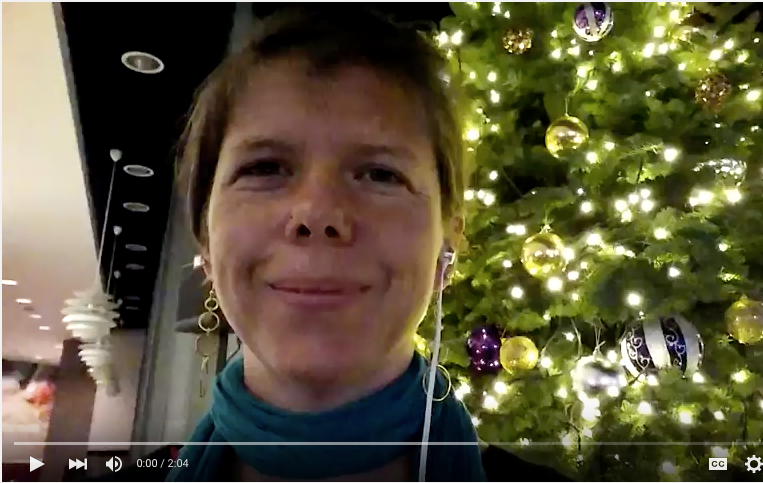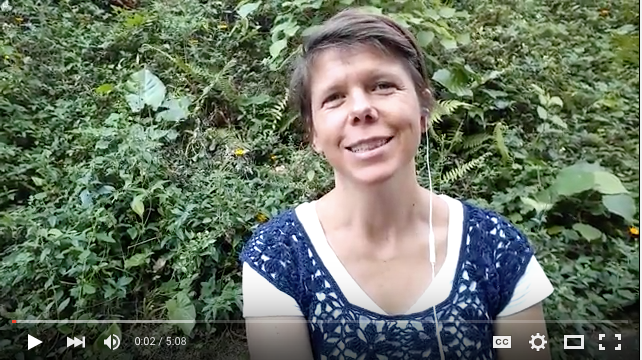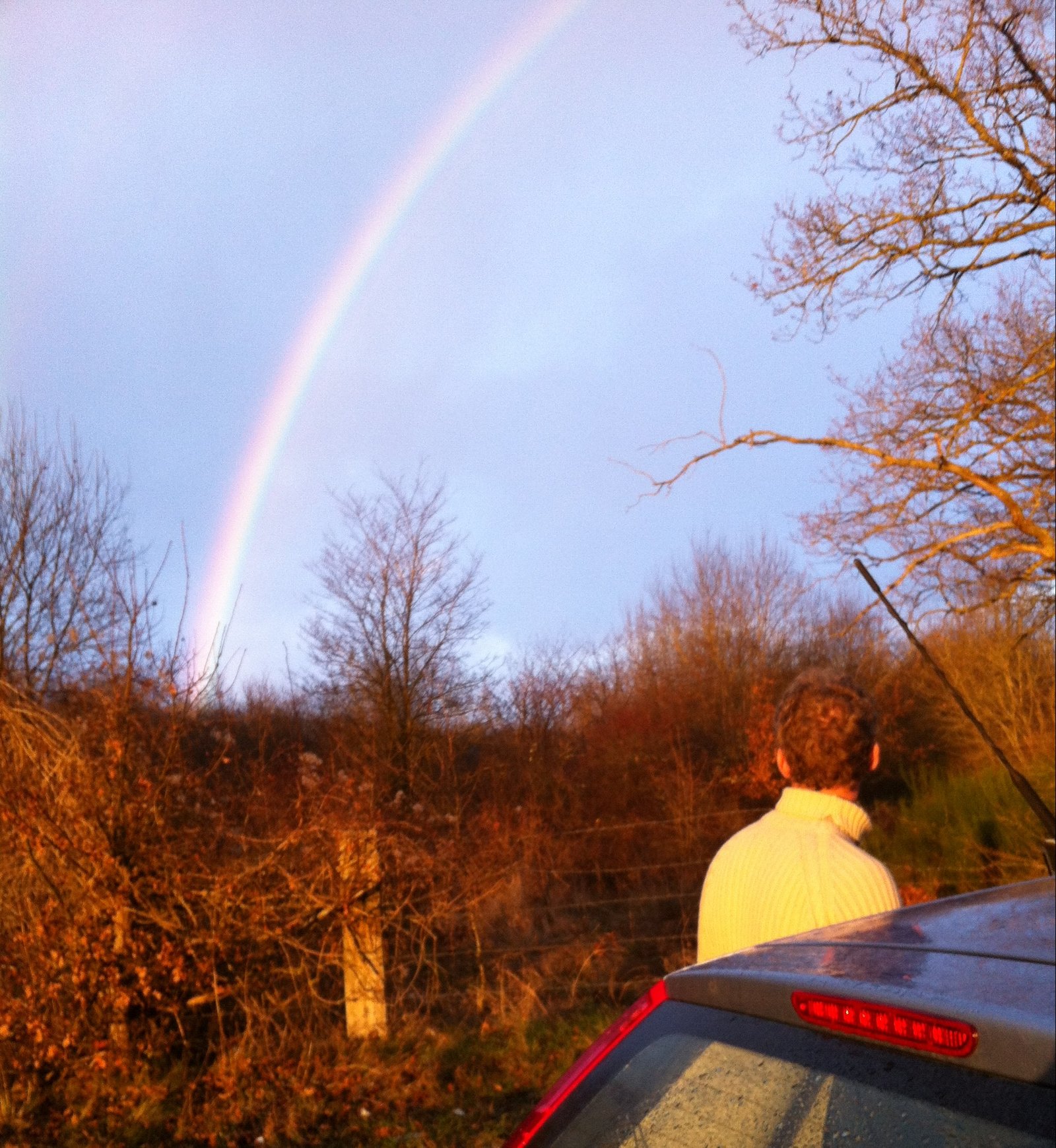
Many meditators ask this question, “How do I stop thinking?” Luckily for you, you don’t have to stop! Here’s an inspired idea I had for understanding why not… Enjoy!

Many meditators ask this question, “How do I stop thinking?” Luckily for you, you don’t have to stop! Here’s an inspired idea I had for understanding why not… Enjoy!

It’s important to trust your meditation practice.
In order to let yourself relax during practice, you need to be okay with whatever is happening. If your mind is in chaos, you need to be okay with the chaos. You need to trust that just sitting there and watching all the chaos really works.
Otherwise, you fall into the trap of trying to fix yourself while you practice. Which just creates more chaos!
Tricky.
To let go of monitoring your success during practice (“Am I relaxing? Am I doing this right? Is this helping me?”), you can measure your success by comparing how you are before and after you practice. Give yourself a number, 1-10, for how you are before practice, then practice, and then give yourself a number after you finish. See if the number gets better after, or not.
You can measure the success of anything you like from stress levels to mental chatter. Give yourself a 0 for no stress or chatter and a 10 for maximum stress or chatter.
Before you practice decide what level of stress, etc you’re at and give it a number, then just practice with out measuring or monitoring, and afterwards check in again and give yourself a number based on how you feel now.
During practice you let go of needing to monitor, and over time as you watch your numbers consistently improve you will build trust in your practice… Making the desire to monitor a thing of the past.
If your numbers aren’t improving, that’s helpful information as well. Check in and see if there’s something in your environment that’s effecting you like too much noise. Check inside, maybe it’s time for help from a meditation teacher, friend, book or video. Or it could be time to ask for help from a therapist if you feel like your issues are too big right now.
Try it out and I’m happy to hear how it goes for you. Happy (monitor free) practicing,
ElenaMariafoucher.com

Many people suffer from depression or anxiety. Sometimes both.
Two ways to address these issues are physical exercise & mental practices.
By physical exercise I mean good old fashioned walking, running, swimming, tennis, volleyball, etc. Whatever you like to do is best.
By mental practices I mean things that focus your mind on creative, enjoyable or positive things. This could be anything from art to cooking if you love them. To be really sure that you’re focusing on positive things, it can be doubly helpful to engage in things that are designed to be theraputic, because they will have this bias built in. Art therapy, dance therapy, psychotherapy (depending on the therapist), etc.
Interestingly, meditation also helps for the mental focus aspect, because it has the natural outcome of letting your mind rest.
Why are these 2 things important? Because they change the chemical habits that you’ve gotten into. They offer natural a natural way for your mind & body to reset to happy versus sad.

Are you struggling during meditation? Trying to calm your mind and it just isn’t working? Feel like the harder you try the less it works?
This is super frustrating! And pretty normal… I’ve been experiencing this with this in my own practice lately.
The trick with this one is to start with your intention firmly in place, “I intend to quiet my mind.” and then once you start meditating to drop your expectation and just to notice what is happening… notice what ever you mind is doing as you meditate.
Remember that if you’re busy thinking that you want to stop thinking… that you’re actually creating more thought! And what ever your intention is, the magic happens when you take the time to notice whatever is happening and just accept it with out trying to change it. If you let it, it will change on it’s own.
Try it and see how it goes. Feel free to comment below with your experiences or questions.

 I’m standing here meditating because I know it helps me get calm and clear… and my mind is racing.
I’m standing here meditating because I know it helps me get calm and clear… and my mind is racing.
Thoughts and feelings are flying through…
…and, sure enough, here they come, the judgments…
“I can’t believe I’m thinking about missing my appointment yesterday while I’m meditating! This is terrible! I really don’t like feeling this guilt. I wish I would stop feeling like this! I shouldn’t be thinking these awful thoughts. I should be focusing on my breath. Will this ever stop?! This is terrible! I can’t do this!”
We’ve all had this happen!
We’re meditating and we have heard that this will clear our minds of thought. When find ourselves thinking instead, we think, this has got to be bad, right? Clearly, we must be doing it wrong if we’re thinking?
Well, sort of.
The issue here is that if we think that we shouldn’t be thinking then we’re generating MORE thoughts. If we think that we shouldn’t be thinking… then, guess what? We’re thinking! We’re actually adding more thoughts in the mix. If we add anger, guilt or disapproval we feel bad as well. This is the polar opposite of calm and clear. We begin to doubt that we can meditate at all or that it is useful to do.
What’s the secret to getting out of this trap?
The secret is to be kind to yourself.
You’re mind is going to think. That’s it’s job. It’s good at it, and this is a good thing! Enjoy it. Appreciate it. It works hard serving you everything you ask of it.
The thing to realize is that you’re asking it for something new. You’re asking it to slow down and get quiet. It can do that. It will just take some time, some practice. Working with your mind will get you there a lot faster than working against it.
Your mind will naturally quiet if you’re kind to it and allow it to do it’s job with out needing it to be another way right now. If you recognize that it thinks a lot and start from there. If you’re ok with what is true right now and work with that. If you don’t fight it and you’re okay with it, then you allow it to change.
The trick is to keep both things in mind: that you’re intentio n is to be quiet AND that you’re okay with whatever is happening right now (quiet or not)
n is to be quiet AND that you’re okay with whatever is happening right now (quiet or not)
.
Kindness works because as we move towards something, as we accept it, it gives what ever it is the support it needs to change. If we do the opposite, if we deny something and disapprove of it then we don’t give it the support it needs to change. It’s left there hanging, with out any help to do anything different. If I help you change then you will change a lot faster than if I just get mad at you for not changing.
I’m not saying that you have to approve of your thoughts, or feel good about what you’re thinking. I am saying that your mind will be quiet faster if instead of getting upset and demanding that it do something that it isn’t doing, you accept what it is doing and start from there. You can’t lead someone out of a place if you don’t first go to where to they are, take their hand, and guide them out. If you stand somewhere else and get mad at them for being where they are, chances are neither of you is going to go very far, very fast.
Here is a simple formula you can use when you practice:
1. Have the intention of focusing your mind on your practice (on your breath, your body, etc.).
2. Have the intention of being okay (kind) when your mind thinks about everything else instead.
3. Build trust in your practice by noticing after you practice wether you’re calmer and clearer. Don’t monitor how well you’re doing during your practice (which creates more thinking!). Take a moment at the end of your practice to notice how you feel.
Be patient with yourself.
Know that you will get better and better and better at all of this over time.
Remember that you can be kind to yourself when you’re having a tough time being kind. If nothing else, you’re practicing being kind to yourself, which is a pretty cool practice in itself. It feels a lot better than disapproval and like most things with meditation, it tends to overflow into all of the other parts of your life which awesome.
Enjoy,
Elena

This week the Five Hindrances to meditation practice keep coming into my consciousness. This is a Buddhist idea about the five most common kinds of thoughts and emotions that distract us during meditation practice.
The five hindrances are:[1][2][3][web 1][web 2]

 “I think that if you do spiritual practice correctly, it reflects and undoes your habits of closure so that when you stop doing those habits you are left in your natural state, which is wide open, loving, radiant, happy, sane.“ -David Deida
“I think that if you do spiritual practice correctly, it reflects and undoes your habits of closure so that when you stop doing those habits you are left in your natural state, which is wide open, loving, radiant, happy, sane.“ -David Deida
At some point I stumbled onto the realization that neither running away from my problems (suppression, denial, distraction, etc, etc) nor the opposite extreme of wallowing in the drama of them was terribly useful for making them any better.
What did and does help is first noticing that something is happening and then being in that objective part of me that can notice how I am in it – while I am also fully feeling it. The exact results of this are variable, from the thought/feeling passing quickly to a lengthy succession of difficult experiences happening one after the other… pain, crying, etc.
And it is not that these things go away and never come back. Indeed they are always available. The one thing that is consistent, though is that they get easier and easier to be with. I get more comfortable with them to the point that when they come I do not immediately react with running or wallowing, but have a choice about how to be in them… “Wow, I’m really frightened. My belly is a rock and my throat hurts. I can see an entire drama arising in my mind about this. I think that I will watch that drama like a movie playing in my mind and not act on it. I can see that it is not true, just what my mind is creating to make sense of this fear that I am feeling.”
This kind of liberation is an immense blessing. Not being ruled by fear, jealousy, greed, anger, pain, etc. is wonderful. And of course, sometimes I am able to notice and accept and sometimes I run or wallow long before I ever realize that something worth noticing is even happening.
In the mean time, I am reassured by the Buddhist idea of The Middle Way, which contrary to its name is not, as I understand it, about staying in the middle, but about balance, about allowing everything as it arrises. The Middle Way says that we should accept all parts of life, all ends of the spectrums; that sometimes you will need one extreme or another and sometimes you will need the paces in between. The Middle Way, or Middle Path does not embrace just one way, it embraces all ways, it stays at the centered in acceptance and accepts everything.
Acceptance is a big deal. It is difficult for me to do. It is hard to accept things that I don’t like or want and yet it is one of the best practices I have found for helping me deal with those things. Acceptance doesn’t mean I have to like those things, it just means that I acknowledge them (versus trying and ignore them) and then let my mind move on to something else (instead of focusing on them and creating drama). Acceptance means that when thoughts and emotions float through, I say hello and let them go.
One thing that you can try is something that I’m using a lot lately to get me through a really tough spot in my own growth. I’m struggling a lot with overwhelming thoughts and emotions about my own self worth and I remembered a Buddhist practice I learned a long time ago in Thailand.
In this practice, when you notice a thought or emotion you say what it is, you name it, and then let it go by actively looking for the next one. In this way you are first acknowledging and then letting go. This is a beautiful way to practice acceptance.
This time, I’ve been thanking what arises as well. A thought will arise and I realize, “Ah, you’re trying to protect me. Thank you for trying to protect me.” This little addition of gratitude makes a big difference. It helps me acknowledge the thought or emotion for the good that it is trying to do, which goes a long way towards accepting it and letting it go versus resisting it or wanting to dwell on it, figure it out or turn it into a drama.
Elena Maria Foucher writes about personal growth on ElenaMariaFoucher.com and teaches Meditation Made Easy, simple tools for relaxation, over Skype. Contact her at Elena@ElenaMariaFoucher.com.
(This article first appeared in the online magazine CoSozo.com.)

 Abandonment has been a strong fear of mine. I find it interesting that on a planet of 7 people that that would be a fear, but there it is. Fears are funny things.
Abandonment has been a strong fear of mine. I find it interesting that on a planet of 7 people that that would be a fear, but there it is. Fears are funny things.
Turns out quite a few of us share this one. Abandonment issues, the fear of lonliness, can feel insurmountable, like a huge obstacle blocking our path.
I used to spend a lot of time as a child unconsciously worried about who I was going to spend time with and for how long and when. Lots of planning and strategizing went into this, schedules and phone calls, conversations and the like. As I grew up and became an adult I started a long process of learning to love myself. I’ve found that one of the wonderful side effects of that journey has been that I don’t worry so much about being alone anymore.
I didn’t even know how I felt about being alone until it started to get better, until I had begun to love myself enough that the fear started to fade a bit.
Much of that fear was unconscious as was all of the things I was doing to avoid it. I would engage people in conversations longer than I needed to, listen to people that I wasn’t interested in listening to, hang out with people I didn’t really like and do things that I didn’t really want to do. I’d do all of this thinking that I was being generous and kind or at worst just filling free time, if I thought about it at all.
And why not? There’s nothing wrong with being with other people. With helping people by listening to their problems, supporting them with my time and energy and getting the same in return.
Except that the motives weren’t clean. What I didn’t realize was that I was doing these things not out of pure compassion or a clean and clear need for help. I was doing these things from an unconscious fear of being alone, of not being liked, friendless, lonely, unloved, abandoned. Icky.
These unconscious fears drove me, and since often I didn’t really like what I was doing or who I was with, I wasn’t giving the best of me nor able to receive the best from them. The whole situation was messy and unfulfilling for me and I imagine for them as well.
Until it all started to change. I didn’t make this change on purpose. I didn’t even realize it was happening! What I did do was slowly start liking myself more and more over time and that allowed me to see, “Hey! I don’t really want to do these things! I don’t really want to hang out with these people! I’m not really happy with these interactions!”
Shew! What a difference liking myself has made! As I like myself more, the parts that I don’t like become more clear. As I get more comfortable, the discomforts become more obvious to see and feel. And to stop.
I’m happy to say that I am much more conscious about how I spend my time and whether it’s fulfilling or not. At this point I don’t worry much about being alone on a social level, and the personal level is slowly unwinding itself as well.
How did I go about liking myself more? How can you go about liking yourself more? Those are great questions!
Honestly, I don’t know which of the things I did were a necessary part of learning to love myself. I’m sure that the people who’ve scaled that mountain all the way to the top can share a better overview of the process than I can. There are lots of books and courses you can take, so look out for those to inform your journey to self love.
One thing I can say for sure is that loving myself as much as I do now means that I have me and that I am enough.
What ever your journey towards self love, if you choose to take it, the view from the top will be worth it. I know because the view from here is totally amazing, and I’m only part way up!
(This article first appeared in the online magazine CoSozo.com.)

 “Sometimes things are so bad that I have to laugh so that I don’t cry.” David Deida
“Sometimes things are so bad that I have to laugh so that I don’t cry.” David Deida
As fas as I can figure, there is no miracle cure for fixing relationships.
There are things that we can do to make them better, tips and tools for improving this or that.
But making the whole thing sublime? Nope. Not that I’ve seen.
Too bad, as far as I’m concerned. It would be great if my relationship with my partner was the cleanest, most beautiful, light bearing thing in my life.
Instead, while it is a source of great joy, it is also happens to be the thing that uncovers my darkest parts. It shows me where my demons are; handily pointing out all of the icky, nasty, icky things that, frankly I would rather just keep hidden in the depths.
On the other hand, this is also one of the greatest gifts that my relationship gives me. It points out in glaring detail and no uncertain terms, where I’m needing growth and change.
It pinpoints exactly where I need to shine some light.
One thing that my relationship has been showing me lately is my tendency to get angry. My partner thinks that I’m the cause of the anger, that I initiate it, and of course I think that he does. Is one of us unconscious about bringing the anger or are we both? This is an endless argument that our shadows could enjoy fighting over forever.
What seems to matter most is, what can we do to stop being angry in the first place?
How can we stop it as it’s happening and even better how can we stop it before it starts?
Great questions.
Usually, if I’m writing about something it’s to share some tip or tool that I’ve discovered to be really helpful. Not this time.
So far nothing that we’ve tried works. This issue seems to require some deep excavation and a big does of bravery as we shine our lights into the recesses… we may need a light house versus our standard flash light approach.
How do we do that, we’re wondering?
We’ll probably use many of the familiar tools for illumination: meditation, journaling, shadow work, inner child work, conflict resolution skills, psychoanalysis, dreamwork, journaling, rituals, etc, etc, etc. Big moments of clarity and insight will happen eventually.
In the meantime, it just hurts, so I’m trying to remember to not take myself too seriously.
I try to remember that we’re both human, having this wacky human experience, that I don’t really know why I’m here and what any of this means… and that in that case I’m free to laugh or cry as I choose. That in the larger sense, there is no clear reason to choose one over the other, so why not choose to laugh?
As I’m looking at this painful issue that feels so abusive with no clear way to fix it, this is the one thing I can think of to lighten the situation. Laughter.
I can cry in frustration.
Or I can laugh with delight… Yay! Another shadow dancing into the light!
Elena Maria Foucher blogs her experiments in joyful living on the Joy Lab at ElenaMariaFoucher.com. She teaches meditation and stress management in Hong Kong and is the creator of simple, quick meditations you can learn while brushing your teeth at ToothbrushMeditations.com.
(This article was first published in the online magazine CoSozo.com)

 I live in a tiny neighborhood at the top of a very long hill. I’m far from the throngs of Hong Kong and ensconced in the wonders of nature. It’s truly an honor to be a citizen of such an urban environment and to live where I can hear crickets sing, watch hawks soar past the balcony and rain sweep over the bay.
I live in a tiny neighborhood at the top of a very long hill. I’m far from the throngs of Hong Kong and ensconced in the wonders of nature. It’s truly an honor to be a citizen of such an urban environment and to live where I can hear crickets sing, watch hawks soar past the balcony and rain sweep over the bay.
Obviously, I live on the outskirts of Hong Kong. Instead of being among the cosmopolite, I’ve chosen to live among an extended family of villagers, kind hearted souls whose grandmother rules the root and does her flock’s laundry each morning. It is a beautiful, clean and quiet setting.
When I moved in I was delighted to notice a lovely husky, well tended, on a chain under a tree at one end of the property. I love dogs and it was great to know our neighbors did too.
Or so I thought. It became obvious pretty quickly that though she was well cared for as far as being fed and her area cleaned twice daily no one spent any more time with her than that. Her caregiver ignored her and no one took her for walks. Ever.
When I gently inquired it turned out that a cousin had installed her there when he moved into an apartment that didn’t allow dogs with promises to retrieve her soon. That was three years ago.
This husky has been on a chain for three years. She’s been there day in and day out. No walks. Wow.
I was shocked.
It was heartbreaking to know that no one cared enough for her to fill her basic need for exercise, and the idea of being confined to a two meter chain, day in and day out was unthinkable. I felt terrible. This was a tragedy that I couldn’t bear. Every time I looked over at her from my balcony I felt so sad I wanted to cry. I couldn’t live next to this kind of cruelty and not do something about it.
What was I going to do?
I asked if I could take her for walks. Grandmother said, thank you, but no. She didn’t want to be liable if anything happened to me or the dog or anyone else. Her reasoning made sense and I knew better than to argue with grandma, so I gave up trying to rescue her that way.
I decided that the least I could do was to send her loving looks instead of showering her with sadness from my balcony. I decided that at least I could send her love, even if from afar.
And that’s when things started to change.
That’s when I got a chance to see this situation from a different place.
As I started to look at her with love and without my filter of tragedy, I began to be able to see her again. I started to be able to see how she felt instead of projecting onto her how I felt. I began to notice that she wasn’t sad at all. In fact, she was quite happy! How could that be, I wondered? I began to watch her carefully, my heart open.
As the days past, I noticed that she took pleasure many things. She wagged and shook with joy every morning and evening as her food was delivered, and took delight in the woman who gave it to her even though the woman ignored her. She didn’t mind. She was still happy to see her. She was content regardless. Amazing.
She enjoyed the scents that wafted up the valley and she would often walk over to the edge and sit and sniff the wind and watch whomever was walking up the hill. And wonder of wonders, she even took herself for walks. What I had thought were the neurotic movements of a trapped animal trying to get off her chain were actually the happy wanderings of an animal content to walk as much as her chain allowed. Almost daily she calmly walked the full perimeter that her chain allowed, stopping now and then to sniff things and check out the latest leaf that had blown over or insect that had landed on the flowers next to her. She varied her walks, going in one direction one day and another way the next.
Mostly, she just seemed content for no reason at all. How interesting. I wondered if I would be able to keep my head up and interested in the world if I were captive. Her interest, her contentment seemed to be a part of her regardless of her captivity.
And all of this would be pure conjecture and me just trading my sad blue glasses for rose colored ones except that I finally got up the nerve to go over and make friends with her. I’ve spent a lot of time with dogs, so I knew to proceed with caution in case she had lost her socialization or was aggressive (defensive) when approached by a stranger. I wanted to make friends, so I was very careful not to scare her. Also, she’s a big dog. With big teeth.
It took me almost a month of slowly gaining her trust before I got close enough for her to carefully sniff my hand. Only, once I finally got there she wasn’t careful at all. I needn’t have worried. Turns out she’s super friendly and loves to say hello. From that moment on, whenever I approach she wags and prances and plays and almost knocks me over with kisses and love. She’s only complained twice when I walked away from her, and both times I knew that I was leaving in the middle of playing and that we weren’t done yet. She was right.
I’ve spent a lot of time with her over the two years that we’ve lived here and I can honestly say there’s so much love and happiness in that dog, it’s astounding. She’s extraordinary. She’s one of the happiest dogs I’ve ever had the pleasure to meet. Probably one of the happiest beings I’ve ever had the pleasure to meet.
She gave me a second chance. A chance to open my eyes and see what is really happening inside her. A chance to see what freedom really looks like. Through her I’ve begun to understand how Nelson Mandela handled all those years in prison, emerging strong and free and whole, and why Moojii said once that a man free in his heart can be in prison and yet be the only free person around.
She shows me that freedom comes from within as I greet her from my balcony every morning. And yet everyday I meet humans walking around in prisons of their own making. The contrast is amazing. She’s free because she chooses freedom. Many of us are in prisons of unhappiness and discontent because we choose them. This dog understands that. I can see that she does. I hope that all of us can understand that as well.
(And bless the aunt who has recently taken her on two walks!! I’m trying not to hold my breath, or bring my needs into it, but I am really happy at this turn of events! May we all be free inside and out!)
Elena Maria Foucher blogs her experiments in joyful living for the Joy Lab at ElenaMariaFoucher.com. She teaches meditation and stress management in Hong Kong and has created simple, quick meditations that you can do while brushing your teeth available at ToothbrushMeditations.com.
(This article first appeared in the online magazine CoSozo.com.)